Category: General

Here’s why modern EVs are more prepared for extreme temps
- Modern EVs don’t suffer the extreme-temp range loss—or degradation—that earlier models did
- Heat pumps and battery heaters have made a difference, as have new battery chemistries
- Automaker testing is part of it, as Nissan points to in Ariya EV
Electric vehicle batteries perform best and last longest in a specific temperature window, but modern EVs are still equipped to deal with temperatures much hotter or colder than that ideal.
As Nissan explained in a recent press release, that’s largely down to equipping vehicles with thermal-management hardware—and validating that hardware with thorough testing.
The Nissan Ariya crossover uses liquid cooling to keep its battery pack at the optimal temperature during hot weather, and a battery heater in colder temperatures. The Ariya also has a heat pump to minimize cold-weather range loss—something the popular Tesla Model Y and Model 3 also have.
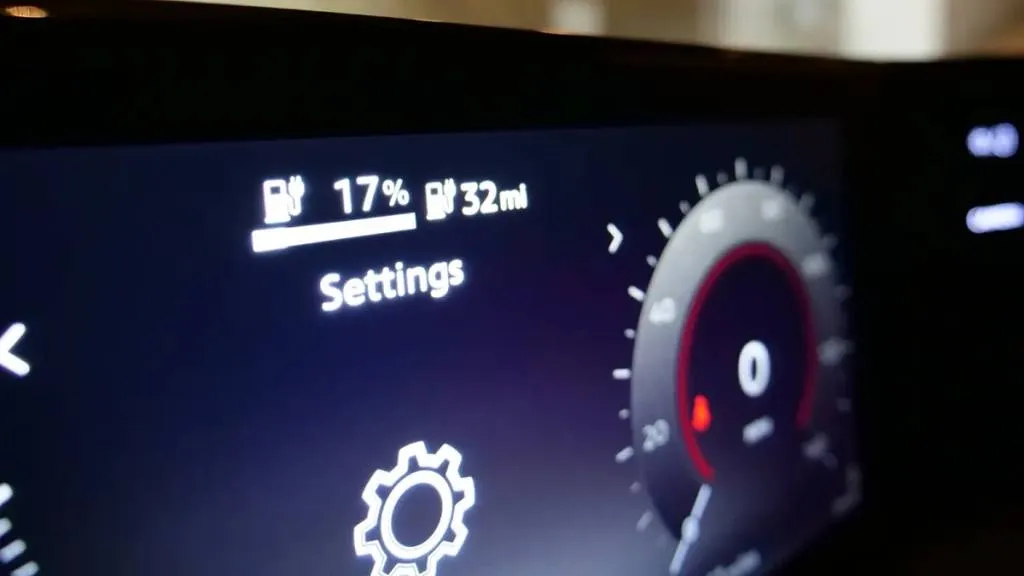
Nissan Ariya cold temperature testing
Like most other major automakers, Nissan tests new vehicles in climate-controlled chambers to monitor extreme temperatures. Such a chamber at Nissan’s Detroit-area technical center is capable of temperatures ranging from -40 degrees Fahrenheit to 176 degrees Fahrenheit, the automaker claims.
In a 24-hour “cold soak” test conducted in 2024, an Ariya was parked in the chamber with a 17% charge at -4 degrees Fahrenheit. After a full day had passed at that temperature, without the car being plugged in or using its battery heater, Nissan claims the charge level was unchanged.
Owners might want to leave a car plugged in, of course, both to charge and to pre-heat the cabin without drawing down the pack. Since they’re not waiting for the waste heat from a combustion engine, EVs inherently warm their interiors faster, too, Nissan notes.
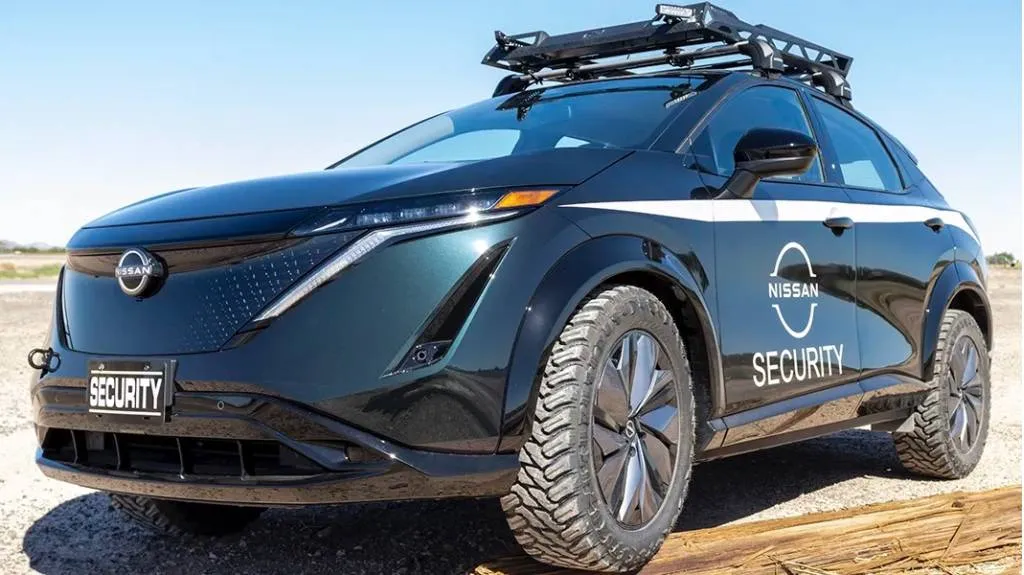
Nissan Ariya security patrol vehicle used at automaker’s Arizona proving ground
Very high temps are a consideration nearly every automaker has allowed for in modern EV development, too. Nissan also uses Ariya SUVs for the security patrols at its proving ground near Phoenix, Arizona, to keep prying eyes away from new models circling test tracks out in the desert. In 2023, Nissan replaced gasoline Armada and Frontier patrol vehicles with a pair of Ariya EVs, which have since covered more than 30,000 miles at the site, where summer temperatures can exceed 115 degrees Fahrenheit. They’re part of a fleet of 10 Ariyas at the facility.
This more thorough testing in extreme temperatures—and wider use of heat pumps and other related hardware—appears to be paying off. Recurrent, which gathers EV driving data to compile battery health reports for used vehicles, found that 20 popular models are now averaging 80% of peak range in freezing temperatures, compared to ideal conditions. That’s based on data from over 18,000 vehicles in the U.S., according to Recurrent.
As with previous studies, Recurrent found that each model performs differently, but that all models surveyed can deliver over 100 miles of range when the thermometer needle drops below freezing. Yes, that even includes the base 149-mile Nissan Leaf. The heat pump-equipped Tesla Model X and Model S performed best, and heat pumps overall averaged a 10% improvement in cold-weather range.
Nissan itself is a good example here for how far EVs have come in adding thermal systems and accommodating for extremes. The original Nissan Leaf EV lacked active thermal management, and its first cells suffered from excessive range reduction in the cold and accelerated degradation from the heat. That was partly solved in 2015 with a new cell chemistry, but as it’s shown here all the advantages built into the Ariya may be worth their added complexity.
It’s also important to remember that whatever range loss owners encounter in cold weather is temporary. Long-term battery degradation is accelerated in hot weather, although research done last year by Geotab suggests that for most new EVs, battery degradation shouldn’t really be a concern—even if you follow habits that had been frowned upon with earlier EVs, like frequent fast-charging.

Honda and Nissan end merger talks with no deal
Honda and Nissan on Thursday terminated a memorandum of understanding under which the two automakers had been discussing a merger, but plan to continue collaborating.
The memorandum was signed by the two automakers in December as the first step toward a merger targeted for 2026. The decision to terminate it comes after discussions by each automaker’s management team and various stakeholders that “considered the surrounding market environment, the objectives of the business integration, and the management strategies and structures post-integration,” a joint statement said.
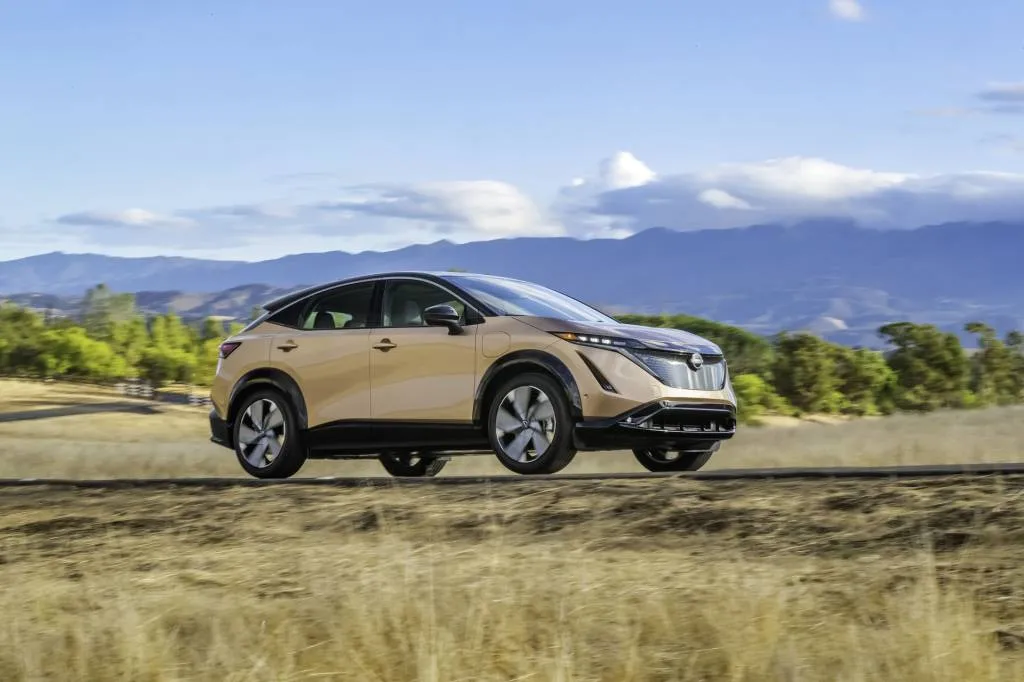
2024 Nissan Ariya
When talks started, both automakers had discussed transferring their shares to a joint holding company, in which Honda would appoint the majority of directors and a CEO. But Honda later proposed making Nissan a subsidiary. A report earlier this month indicated that this was jeopardizing the planned merger. Such a structure would diminish Nissan’s decision-making authority, and had reportedly caused the automaker to withdraw from negotiations.
Both companies agreed to cease merger talks in order to “prioritize speed of decision making and execution of management measures in an increasingly volatile market environment heading into the era of electrification,” the statement said. But the two automakers will continue working together.

Honda 0 Saloon prototype
“Nissan and Honda will collaborate within the framework of a strategic partnership aimed at the era of intelligence and electrified vehicles,” the statement said. The automakers signed a memorandum of understanding for a strategic partnership covering EVs, hybrids, and software in March 2024 that will continue to move forward, Nissan indicated.
The merger would’ve been a lifeline for Nissan, which has been struggling with declining sales globally, particularly in the U.S. and China. Nissan also owns 34% of Mitsubishi, and the two automakers collaborate as part of an alliance with Renault, but Mitsubishi was reportedly planning to stay out of the proposed merger with Honda.

2025 Ram ProMaster EV electric van costs $58,490
Stellantis is now taking orders for all three versions of the Ram ProMaster EV electric van family, with deliveries to begin in the second quarter of this year.
When it announced the ProMaster EV just over a year ago, Ram said it would be offered in a delivery van configuration and two cargo van options. The delivery van went on sale as a 2024 model; now the two cargo options are arriving for the 2025 model year.
The cargo models include a standard 12-foot cargo length with an extended 13-foot length optional, both with a 159-inch wheelbase. This front-wheel-drive van has a single electric motor producing 268 hp and 302 lb-ft of torque in both cargo models, as well as the delivery van.
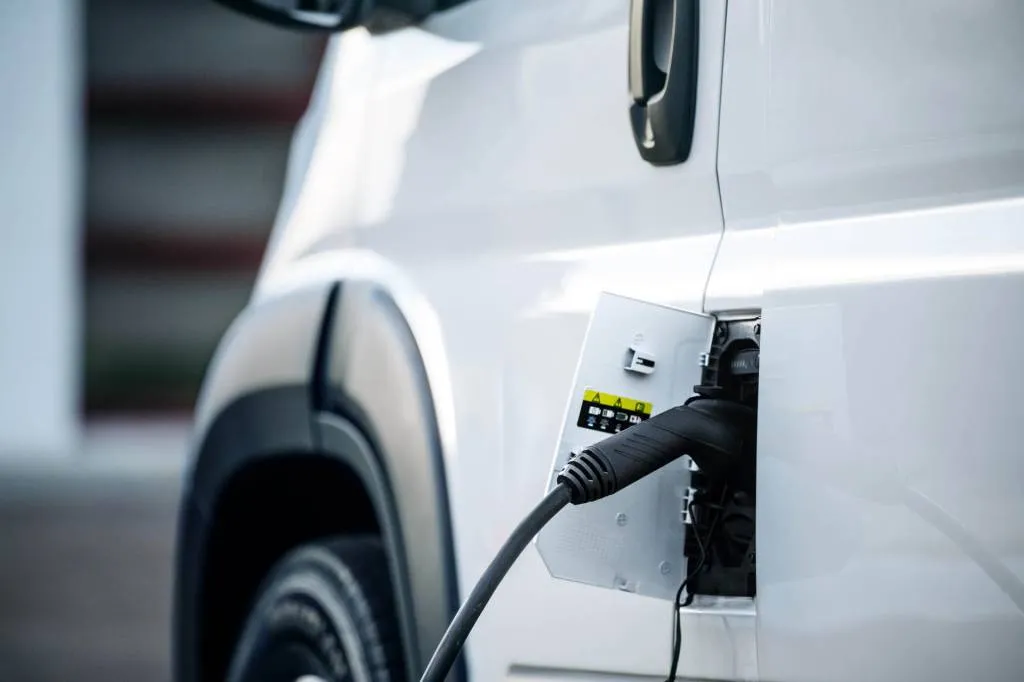
2025 Ram ProMaster EV Cargo Van
A 110-kwh battery pack, below the center of the vehicle to maintain a flat cargo floor, delivers an estimated 164 miles of range in the cargo vans and 180 miles in the delivery van. Ram also claims a maximum payload of 3,020 pounds for cargo vans and 2,876 pounds for the delivery van, with volume unchanged versus equivalent internal-combustion models.
Prices start at $58,490 for the cargo models and $71,990 for the delivery van. That means the 2025 Ford E-Transit remains the lowest-priced electric van, at a starting price of $53,095. But at only slightly more for more range and battery flexibility, the ProMaster also appeals on value.
And it significantly undercuts the $82,900 base price of the Rivian Commercial Van 500 recently announced, with similar range. That van is similar in design to the one Rivian once sold exclusively to Amazon; following the end of that exclusivity deal, Rivian is now opening electric van sales to all fleets.
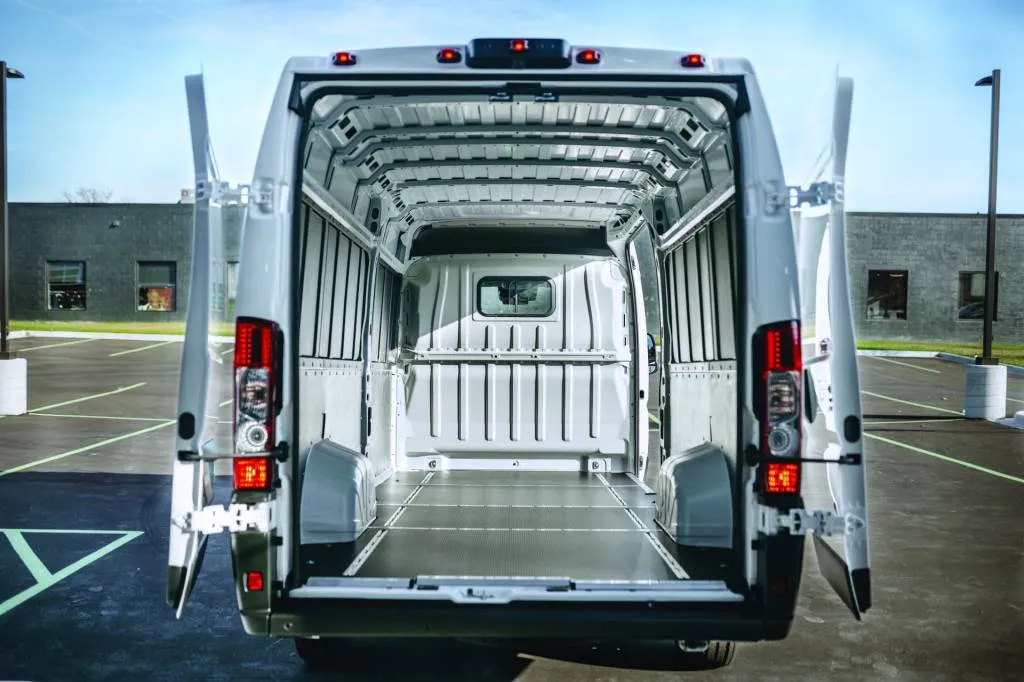
2025 Ram ProMaster EV Cargo Van
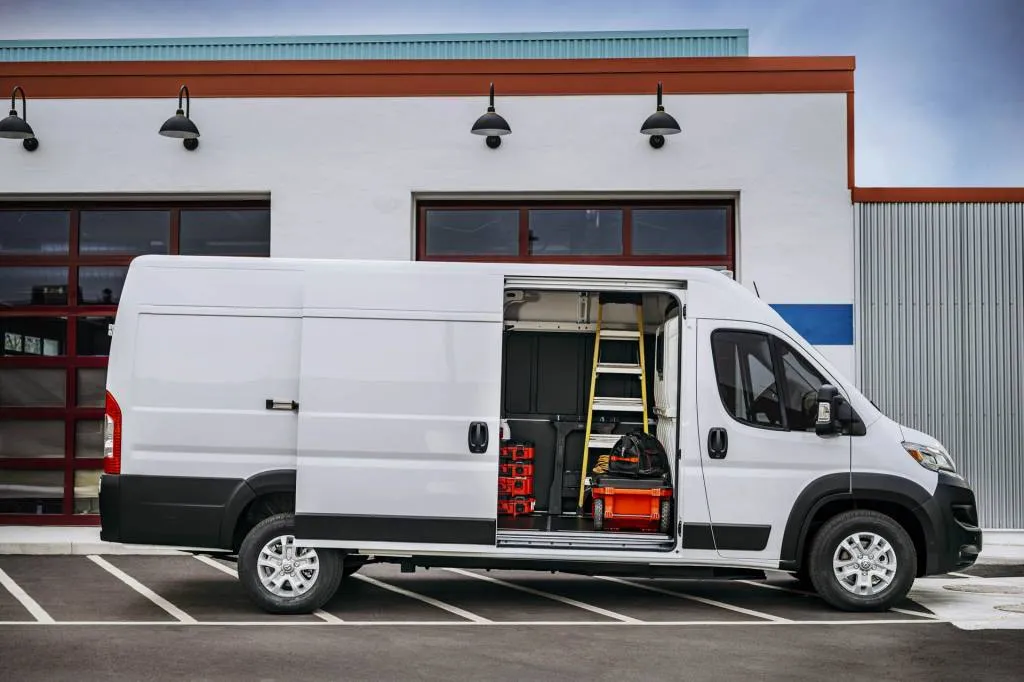
2025 Ram ProMaster EV Cargo Van
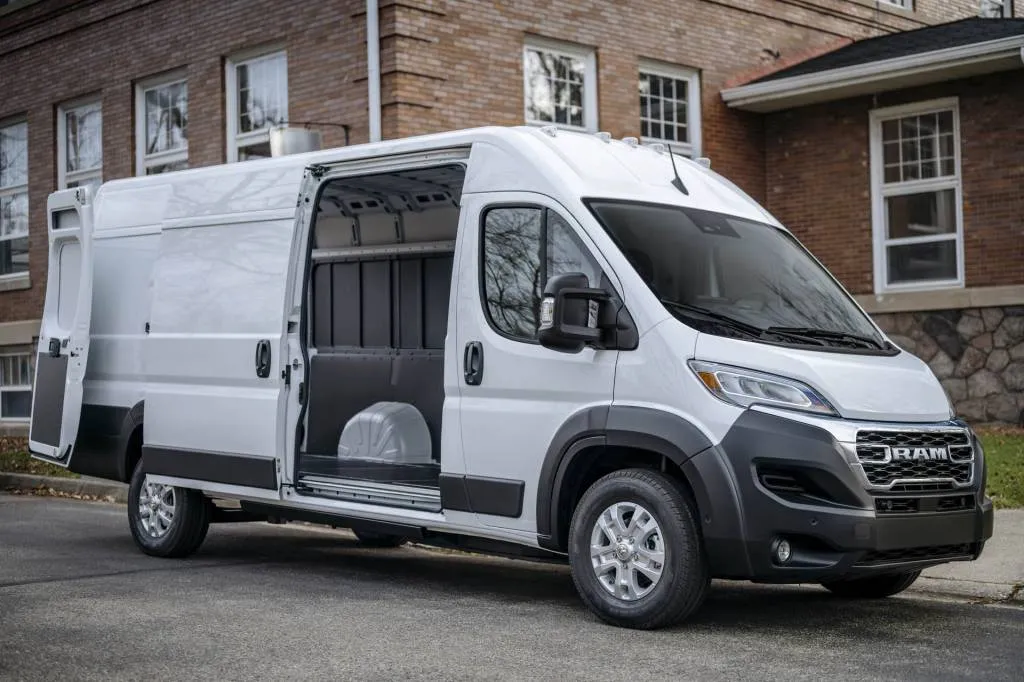
2025 Ram ProMaster EV Cargo Van
The Rivian is based on an EV-specific platform, but the ProMaster EV and gasoline ProMaster share underpinnings. That’s also the case for the Ford E-Transit and current Mercedes-Benz eSprinter—although a family of standalone Mercedes electric vans is on the way within two years. General Motors has also designed electric vans from scratch, even marketing them under the separate BrightDrop brand for some time, before folding it into Chevrolet.

BMW R&D boss: Bigger batteries in EVs “don’t make sense”
- Bigger battery packs bring an inflated carbon footprint
- Solution is higher efficiency and reeling range in to a real-world 300 miles
- Six upcoming Neue Klasse EVs will follow this philosophy
BMW aims to grow its electric-vehicle momentum with its next-generation Neue Klasse family of vehicles, but it won’t be doing that with big battery packs.
“You can’t make battery packs bigger and bigger because then BEVs don’t make sense anymore,” BMW chief development officer Frank Weber said in an interview with Automotive News Europe published Monday, arguing that chasing ever-bigger range numbers with ever-larger battery packs would lead to a penalty in the form of an inflated carbon footprint.
Bigger battery packs could indeed lead to more emissions from their manufacture—plus a range of farther-reaching consequences. One 2022 study suggested heavier EVs would also mean increased particulate emissions from tires wearing down more quickly under the added weight of those packs. They’ll also strain the supply chain, which has been shown to be fragile over the past few years.
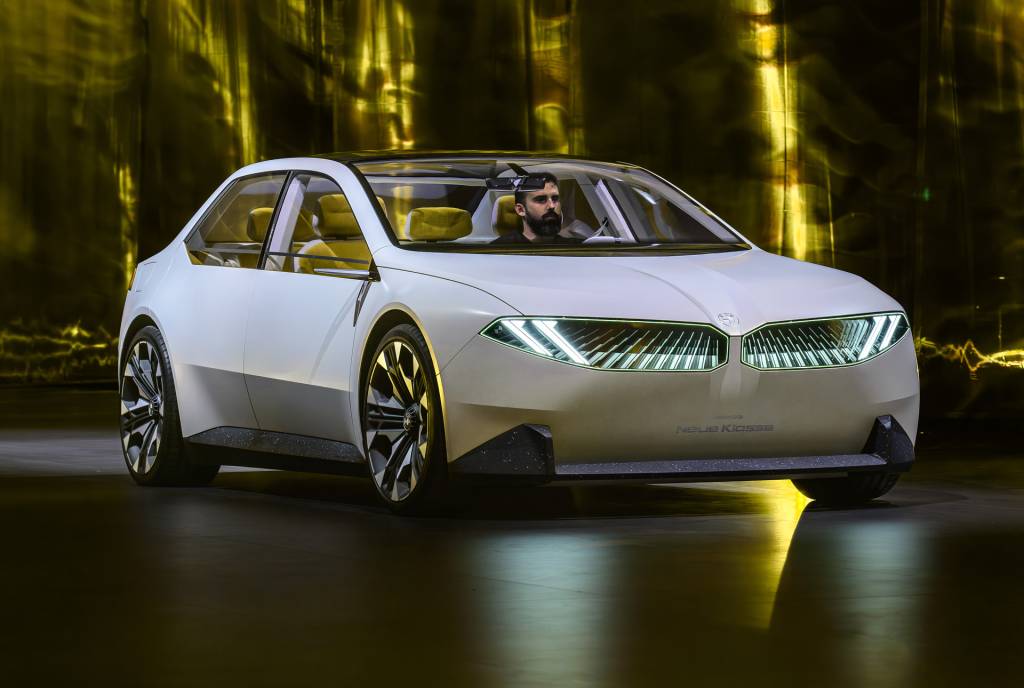
BMW Vision Neue Klasse concept
“Improving efficiency is much more important than ever-larger batteries,” Weber said. “And this is exactly what we are doing with the Neue Klasse, which makes efficiency leaps of up to 20%, depending on the model.”
At a certain point, increased range is also unnecessary, Weber said, noting that current BMW EV customers are happy with 250 to 310 miles of range “under real-world conditions.” BMW is finding that this amount of range allows customers to complete most trips without charging, Weber, said, adding that BMW still is aiming for a 30% range boost over its current models with the Neue Klasse.
Those comments echo what Green Car Reports and a rather small group of automakers have emphasized for years—that range is a red herring, and that no one needs a 500-mile EV. But now that philosophy is being applied to what BMW has promised will be a large family of fairly high-volume models.
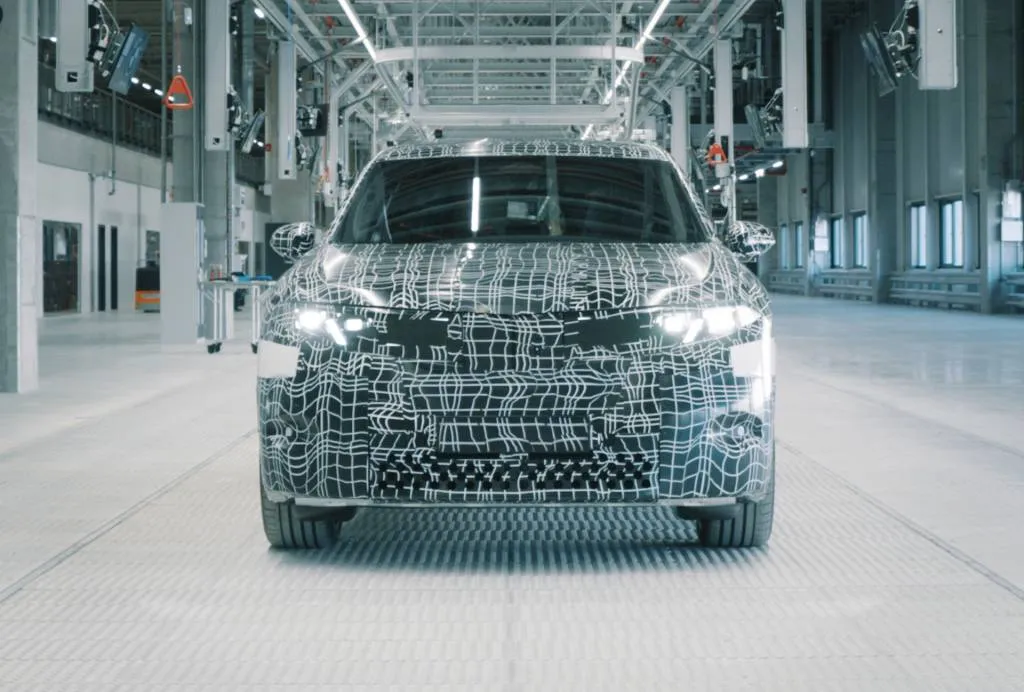
Pre-production example of first BMW Neue Klasse electric vehicle at plant in Hungary
BMW plans to launch six Neue Klasse EVs within the next two years, Weber told Automotive News Europe. The first of those models, an electric crossover SUV, is expected to start production later this year. The first vehicles will be built in Hungary, but BMW has said factories in Germany and Mexico will build Neue Klasse models as well.
Those models will reverse BMW’s current trend of basing EVs on existing gasoline vehicles, although Weber pointed out that they’ll still share elements with other BMW models, such as the new dashboard display the automaker unveiled last month at CES 2025. During media roundtables at that show, Weber also said the upcoming EVs will set the design template for future gasoline BMW models.

Report: GM, Ford seeking gradual EV tax credit phaseout
Automakers are already preparing for the federal government stop electric vehicle tax incentives, lobbying for a gradual phaseout rather than an abrupt end, Bloomberg reported Tuesday.
Several automakers, including Ford and General Motors, along with industry lobbying groups, have asked the Trump Administration and Republican Congressional lawmakers to preserve some EV incentives from the Biden Administration’s Inflation Reduction Act (IRA) as long as possible, according to the report, which cites anonymous sources familiar with the matter.
The IRA, with its manufacturing incentives and tax credits, was predicted to double EV sales by 2030 vs. the previous forecast. But by all previous accounts, the Trump Administration was aiming to make nixing the federal EV tax credit a priority—with support from Elon Musk and Tesla.
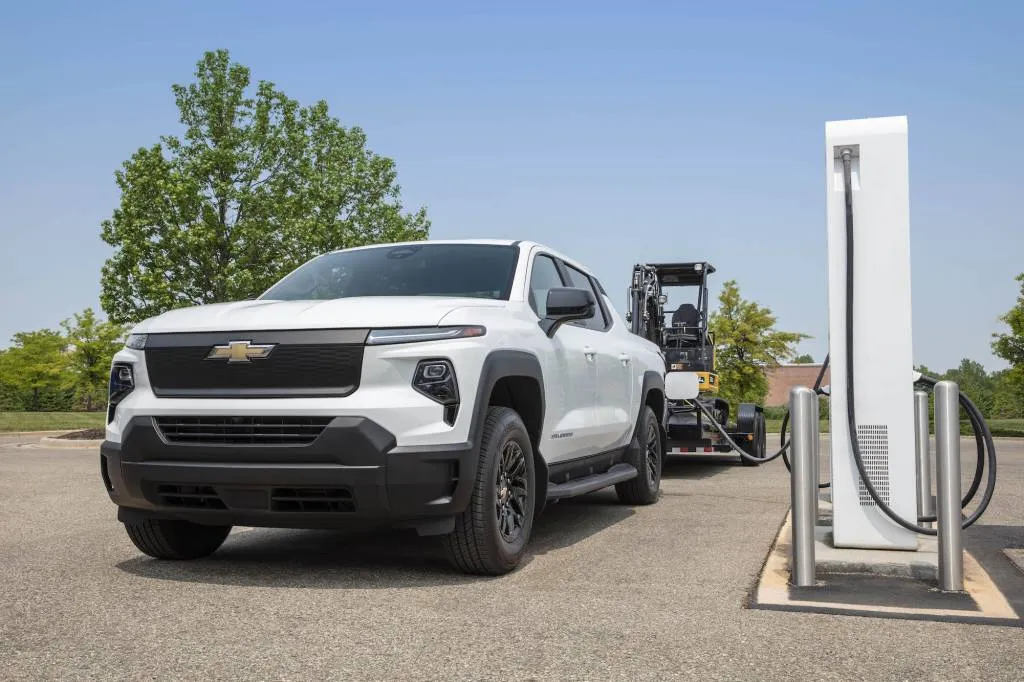
2025 Chevrolet Silverado EV
According to this report, one of the ideas being discussed in the event that Trump eliminates it is a three-year credit sunset that would buy more time to reduce costs of new EVs and make the loss of the tax credit less impactful.
Automakers are reportedly also rallying to keep the so-called leasing loophole that allows automakers with captive financing companies to get a $7,500 tax credit for leased vehicles, and pass the savings on to the customer. This allows for an equivalent discount on EVs that wouldn’t normally qualify for the credit due to price, battery-materials sourcing, or the customer’s income.
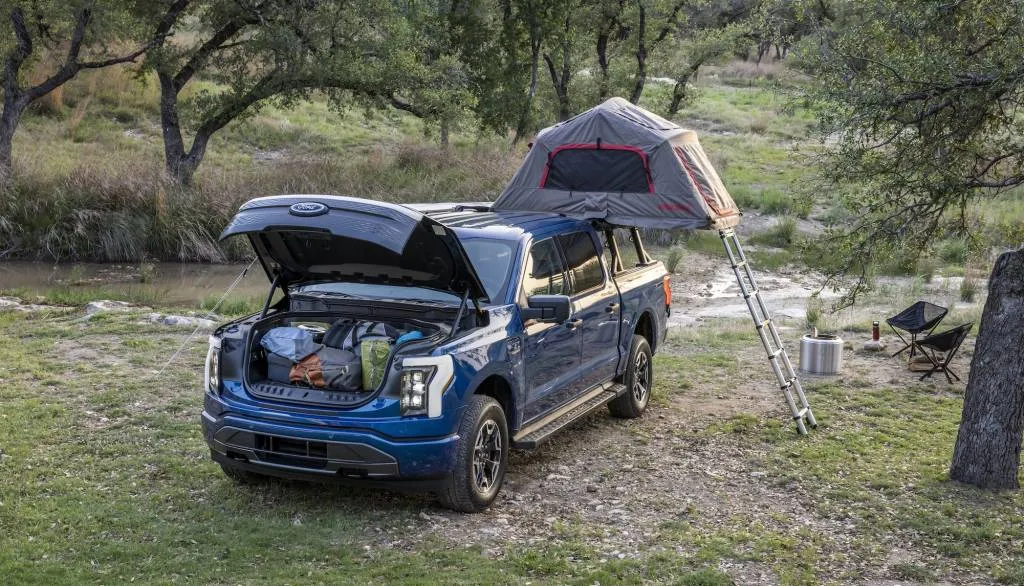
2025 Ford F-150 Lightning
That led to a surge in EV leasing in recent years—with federal money subsidizing luxury EVs built in other countries. That’s likely not going to be a winning argument in Congress, where the IRA’s EV tax credit barely squeaked through the first time around.
Even if automakers fail to convince Republicans to keep the federal EV tax credit, increased state incentives may help make up for it. California plans to provide its residents with $7,500 rebates if Trump kills the tax credit, but it’s seeking to exclude Tesla, ostensibly to provide more incentives to brands with less market share in order to promote competition.

Scout extended-range PHEV tech, platform could be scaled to other vehicles
- EV version offers 350 miles; bigger battery would be detrimental
- EREV system will go 150 miles on battery, then 350 miles on gasoline
- Promises full system performance whether on battery or range extender
- Rivian-based architecture promises to keep electric trucks “fresh”
It’s been nearly two years since Volkswagen’s Scout Motors electric SUV brand announced a $2 billion South Carolina factory and started to emerge from stealth mode. But it will be another two years before these models are due for their first deliveries.
Based on the reveal of its Traveler SUV and Terra pickup in concept versions shown last fall, including prices said to start under $60,000, and executive comments thus far, Scout has laid out some of the basics for the brand.
Scout will, on one hand, offer a look back to the past: rugged EVs with squared-off styling inspired by the classic International Harvester SUVs made from 1960 to 1980. It won’t be a ruse either, as Scout promises to build unparalleled DIY, back-to-basics simplicity into these trucks, with an approach that makes them easy to repair yourself.
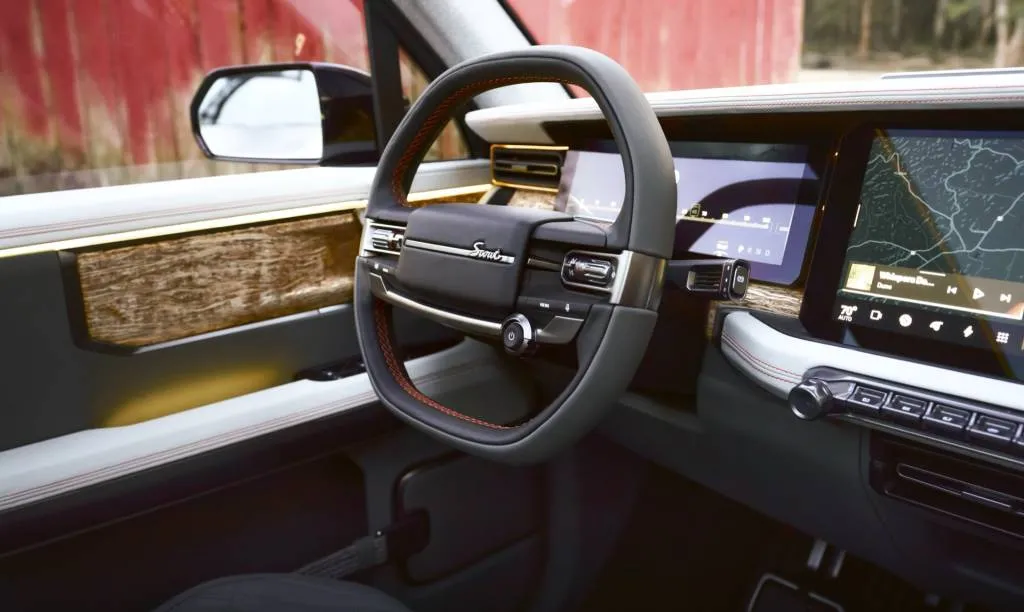
Scout concept interior
But on the other hand these trucks will be backstopped by some leading-edge elements, including a completely new infotainment interface called Community UX, plus a zonal architecture and software-defined vehicle basis conceived by the new joint venture between the VW Group and Rivian. That’s an exciting point, and it opens up all kinds of opportunities that could add complexity or simplify, depending on the end product.
Could Scout’s standout pairing of nuts and bolts and clicky buttons, crossed with the potential of satellite-data-delivered feature upgrades, help make EVs popular with a new group, or will it be the McDLT of electric SUVs?
It sounds like quite the balancing act from a technology and engineering perspective, and that’s why Green Car Reports checked in with Scout Motors chief technology officer Burkhard Huhnke last month at CES. As these models push ahead from the concept to the prototype stage, the CTO revealed various details about the brand, the trucks, and the tech.
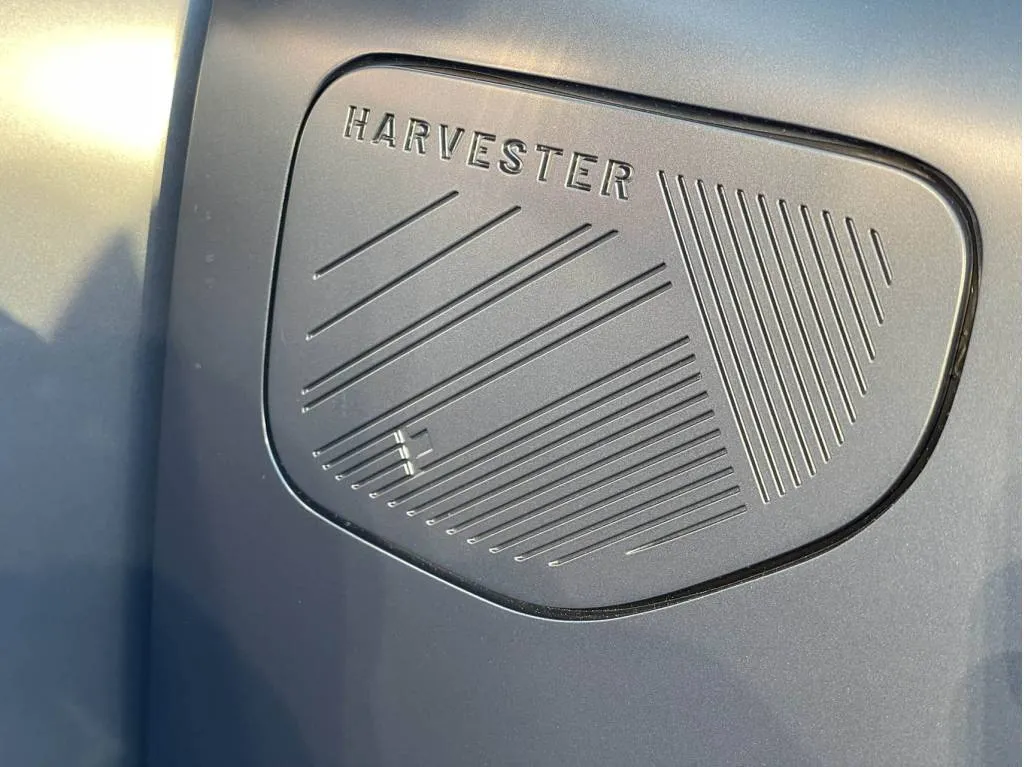
Scout Terra concept
Scout: Trailblazing EV range-extender layout
From an engineering standpoint, the elephant in the room is that, among Volkswagen Group’s core passenger vehicle brands—VW, Audi, Porsche, Lamborghini, and Bentley, plus Seat, Škoda, and Cupra—Scout is trailblazing. There is no current body-on-frame SUV and there’s never been an EV with a range extender.
“It’s of course an opportunity,” said Huhnke. The CTO underscored that it’s the first body-on-frame vehicle in the group, the first model with the ladder-frame concept, and the first such vehicle with an EREV propulsion system (a plug-in series hybrid system, to be dubbed Harvester). “Everything has been developed as a unit—platform—which has the opportunity as a flexible platform to be scaled, maybe, in the future,” he said.
“Our IP has been generated in-house,” said Huhnke, about the EREV system, referring to it as another core competence for Scout. So the engine, the generator motor, and other components will come from elsewhere in the VW Group, Huhnke verified, while Scout is managing it all in a unified system.
“The operational strategy, it’s completely ours,” he elaborated. “We cannot build an engine ourselves, but the range extender itself is so charming; you’re using a BEV architecture underneath and just carrying a kind of DC charging system with you.”
Huhnke didn’t give any hints about what engine, or type of engine, might be used here from the vast VW Group parts bin. But addressing a potential sore point—ask some former BMW i3 REx owners—he assured that drivers would have the “full performance of the system” whether using the battery or constantly charging from the range extender. Based on cutaways shown by Scout Motors, the range extender will be small, and will mount not under the hood but at the rear of the vehicle, behind the rear axle and under the cargo floor—an approach that will maintain the frunk but hopefully not impinge on off-road angles.
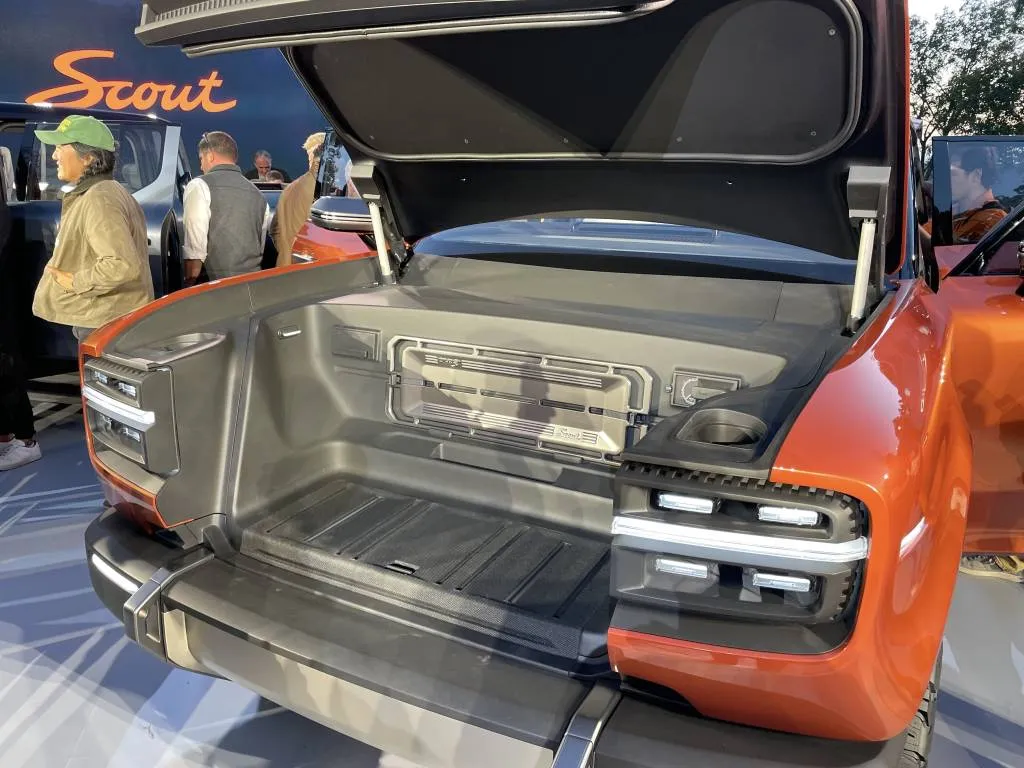
Scout Traveler SUV concept
Why does Scout EV peg 350 miles of range?
Why did Scout decide that 350 miles is enough for the BEV, while Rivian, for instance, pushes to 410 or 420 miles and the Chevy Silverado EV and Cadillac Escalade IQ push it out to 460 miles?
Put bluntly, it may be close to the limitations of what fits within the ladder frame. But Scout also didn’t want to be seen in the same company as models like the GMC Hummer EV, Huhnke let on. It’s a matter of keeping weight under control—which is what the EREV version achieves.
Cramming in more batteries, Huhnke explained, would be detrimental. “You can increase the driving range by adding more and more capacity into the battery, and that’s increasing the weight drastically,” he said. “Or it’s maxed out by the existing space of the ladder frame.”
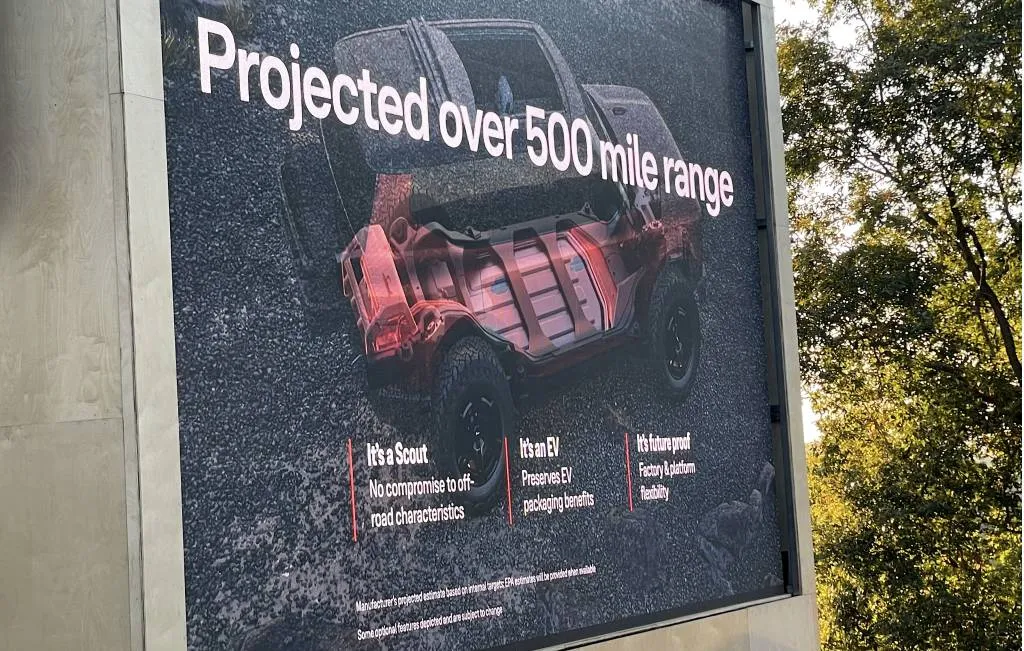
Scout claiming 500 miles with in gasoline range-extender form
Huhnke said that the EREV version—which Scout CEO Scott Keogh recently said more customers were ordering because of range anxiety—will deliver an electric driving range of around 150 miles, then an additional 350 miles with the range-extender. “So in total, 500 miles, that should be sufficient; it’s a trade off in between the weight equation and the capacity of the battery.”
The only other fully electric models that ride on such a setup—body over ladder frame—are the Ford F-150 Lightning and the Mercedes-Benz G-Class EV (or G580 with EQ Technology, in Mercedes marketing parlance). The latter fits a 116-kwh battery pack inside the frame rails, while the Lightning fits up to 131 kwh. Scout hasn’t said what size its battery packs are, but it makes clear it didn’t want to go super-sized.
GM’s full-size electric pickups and SUVs, as introduced in the GMC Hummer EV, employ a structure that combines aspects of body-on-frame and unibody construction, relying on a thick battery pack to provide some of the structural benefits of a frame. But these models’ curb weights soar past 9,000 pounds.
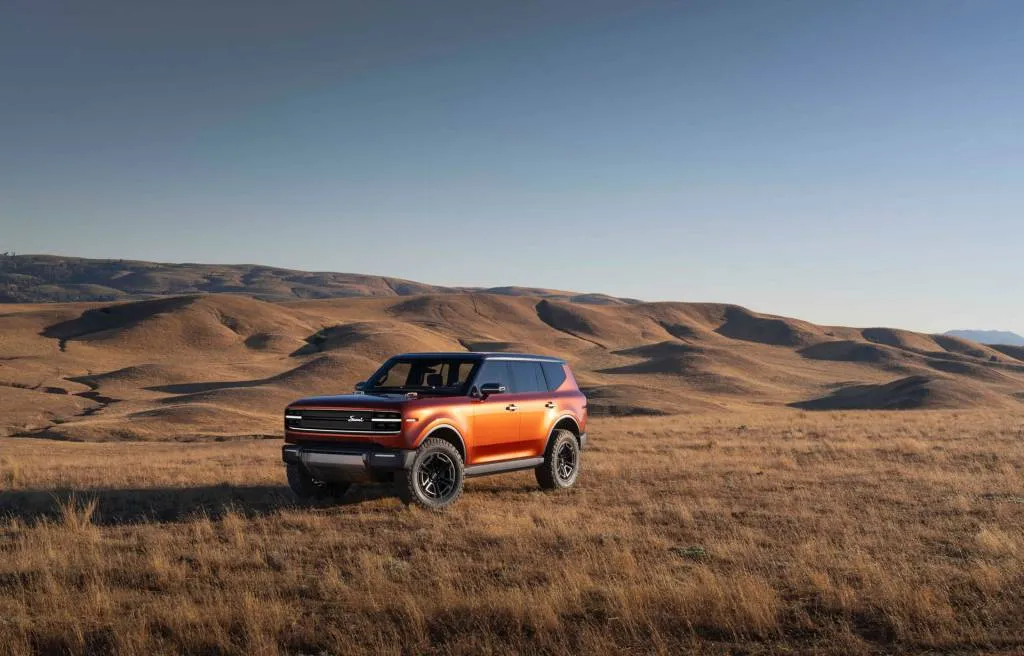
Scout Traveler concept
Scout EVs will be off-roaders to the core
Scout will also need a new level of traction and stability control systems catered to off-road situations—and Huhnke assured that these are taking form in-house together with chassis and propulsion development.
“We are going to have an air suspension integrated as a suspension system itself (his emphasis),” said Huhnke, which will allow new levels of tuning and reduction of noise, vibration, and harshness (NVH). And he says it’s how Scout reconciles this with off-roading that will be another core competence.
“We had decided to have this off-road capability, and therefore we decided to use a more conventional approach on the chassis and propulsion system,” he said. “That means we have one e-beam (an electric motor incorporated into a solid axle), for instance, as the rear axle.”
How much of all of this is truly being engineered by Scout Motors? Some development is happening within Scout, plus “competence in-house to design, simulate, and run durability testing,” explained Huhnke. “Of course we are working together with suppliers. We cannot just hire an entire team; that doesn’t make sense.”
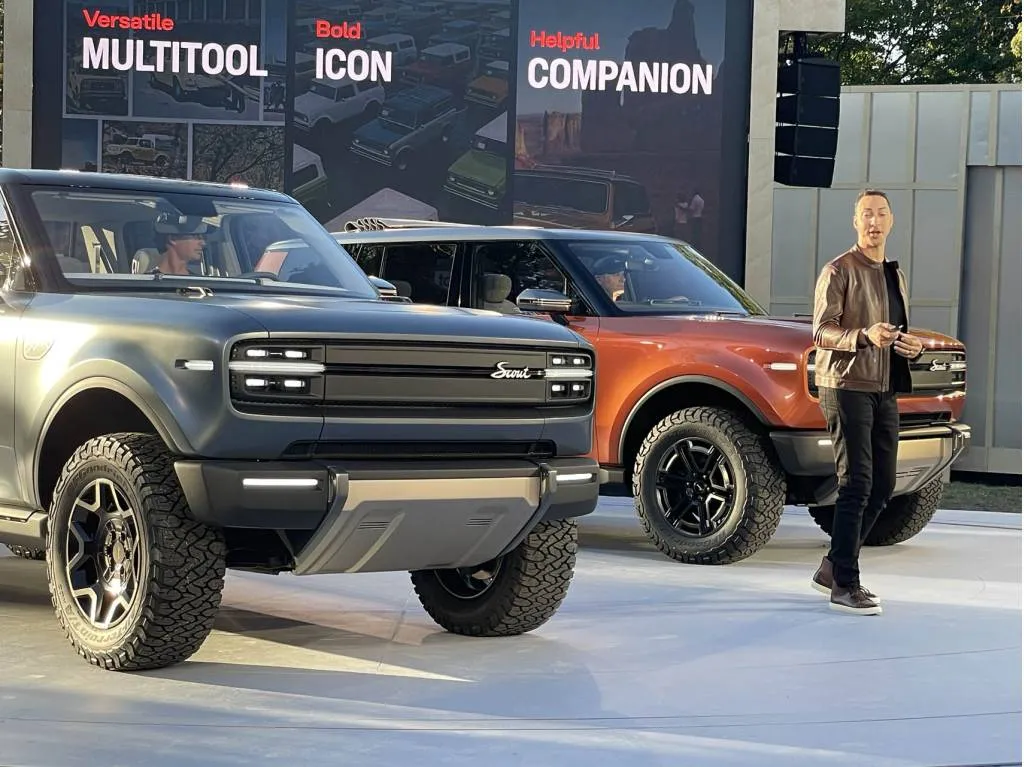
Scout Terra and Traveler concepts
Optimizing for weight, aero, sustainability
What Scout is doing a lot of in-house is optimizing, via a development path that’s been different than anything the VW Group has made up to now, Huhnke explained. Development has emphasized the use of AI and digital twins—one of the auto-industry tech buzzwords of the year—allowing the team to test structural details, design details, or engineering changes underneath, in a way that wasn’t possible before without physical prototypes.
“Combining the full compute power in 3D models with a combined AI approach gives us instant results for changes in aerodynamics or structure,” said Huhnke, adding that having a new factory and its higher levels of accuracy will make the most of this fine tuning.
On the way from concept to production-bound prototypes, that’s been especially useful in reconciling the design from chief design officer Chris Benjamin’s team with underbody airflow. Huhnke said that it will also help the team achieve its targeted top U.S. safety ratings from the NHTSA and the IIHS.
You won’t find carbon fiber in the Scout trucks, nor much aluminum. The Scout electric trucks follow a “traditional materials approach,” said Huhnke, but the optimization approach and simulation is leading to a serious weight reduction. It made decisions to emphasize steel partly based on carbon footprint, he said. “We are carefully going through the material list and optimizing from that standpoint,” said Huhnke. “If you talk about carbon fiber, it’s always appealing to be used from a weight optimization perspective, but not from the sustainability perspective.”
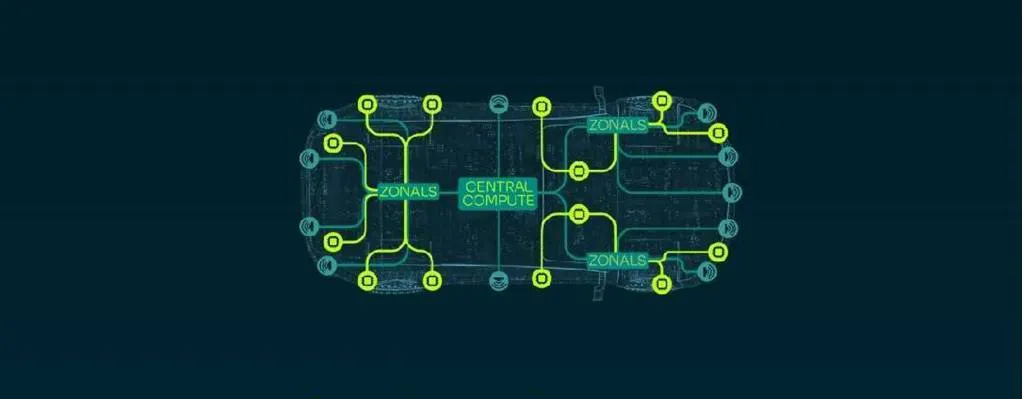
Rivian and Volkswagen Group electrical architecture and software stack
Radically different, Rivian-based underpinnings
While the body-on-frame and solid-axle underpinnings suggest a conservative approach to these vehicles overall, what’s underneath connecting components will be one of the most leading-edge layouts in the industry.
“With the new joint venture between VW and Rivian, we have a chance to use zonal architecture as one of the first brands, and that gives us the OTA opportunity we always wanted to have,” said Huhnke. “So new features, new updates over a lifetime…we’ll keep the cars fresh.”
The CTO is referring to the adoption of Rivian’s zonal architecture, which allows a vast reduction of the number of separate control units around the vehicle, and a reduction of the amount of wiring, connectors, and other associated pieces. With software-based controls for zones, it gives much more flexibility to roll out changes that could retune, refine, or redefine how a core component works—the dream of the software-defined vehicle.
Scout has confirmed that its electric trucks will run on 800 volts, and be capable of charging at up to 350 kw—and that they would support some level of bidirectional charging capability. Altogether, that might make it more advanced in some fundamental aspects than Rivian’s current R1 lineup while also harnessing Rivian’s more advanced electronics architecture. The VW Group pioneered 800-volt systems in the Porsche Taycan and Audi E-Tron GT, and it’s now in a growing group of PPE vehicles including the Porsche Macan Electric and Audi Q6 E-Tron.
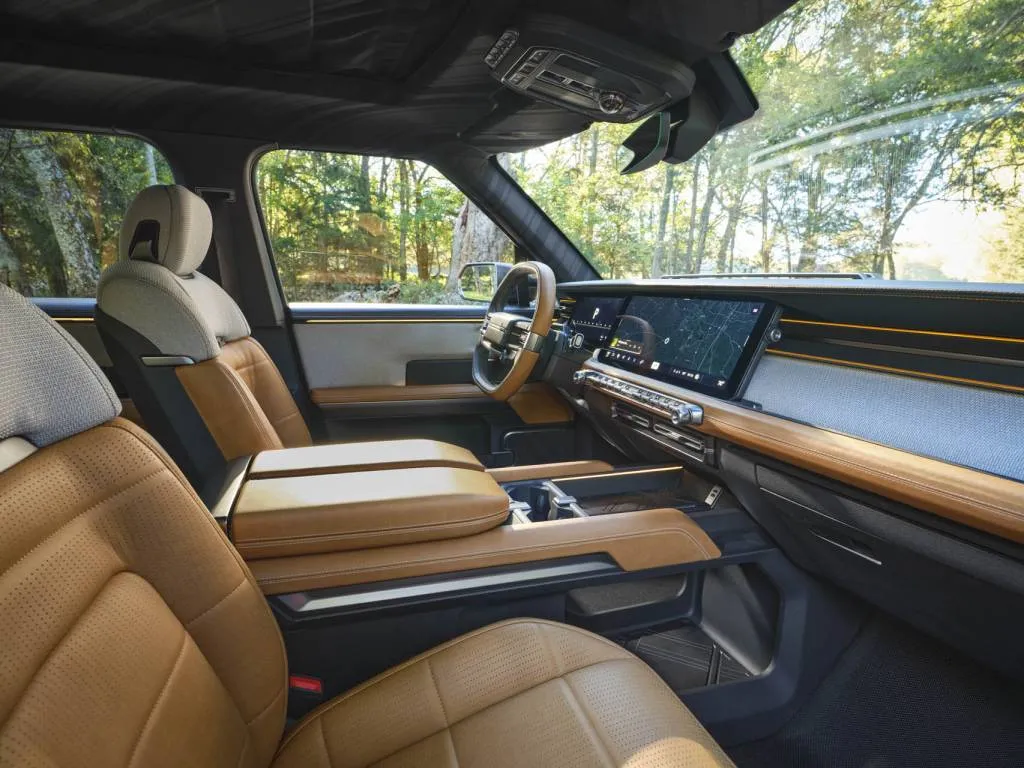
Scout Traveler concept
But there are lots of details yet to come. Scout will emphasize tactile buttons and controls and won’t bury items in infotainment menus, Huhnke promised. Yet the Scout trucks will be able to both monitor vehicle diagnostics and manage predictive maintenance with cloud-based services, with push updates when required. It also plans to build satellite internet into its trucks, but Huhnke suggested that it’s still working out how to make that a seamless part of the experience.
Two years from now Scout will provide a very different experience versus Rivian models, and perhaps a different experience versus any other EVs on the market. Whether or not it’s a hit depends on price, specs, and more, of course, but perhaps more so, whether truck types are charmed by this very original mix of the past and the future.

Mercedes-Benz EQB recalled due to potential battery fire
Mercedes-Benz is recalling 7,362 EQB electric SUVs due to a battery issue that could lead to fires, and it’s asking customers to avoid fully charging until a remedy is implemented.
The recall covers certain 2022-2024 Mercedes EQB models that received battery cells from an early-production batch. These cells could be more vulnerable to internal short circuits under certain conditions, such as current ripples from charging equipment or damage to the battery pack, according to the NHTSA. That presents a fire risk both when the vehicle is being driven and when parked.
Owners will see a battery-malfunction warning message in the instrument cluster should any problems occur while driving, but there may not be any external indication of a problem when the vehicle is parked and shut off, the NHTSA noted.
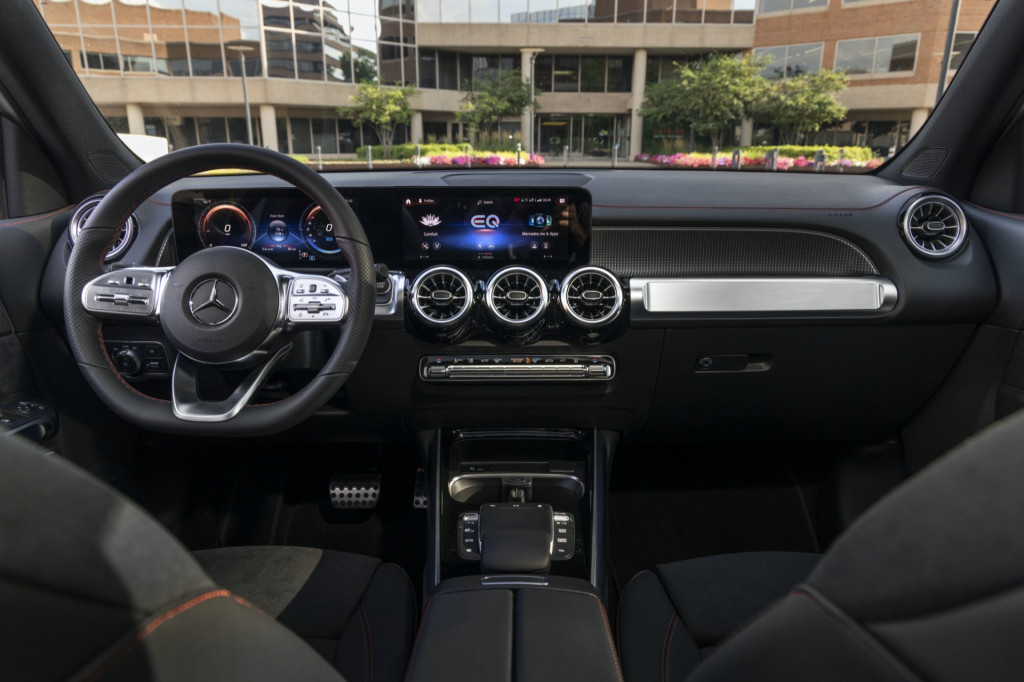
2022 Mercedes-Benz EQB 300
Mercedes told the NHTSA that it was not aware of any fires or related warranty claims in the U.S., but that it first became aware of the problem through reports of fires in other markets. Changes in the manufacturing process used by the battery supplier to address the issue have been implemented in vehicles manufactured after Jan. 24, 2024, Mercedes said.
Owners of vehicles manufactured before that date must take them to dealerships, where updated battery management software will be installed free of charge.
In the meantime, Mercedes instructs owners not to charge beyond 80% battery capacity. Given its 2024 range ratings of 205 to 251 miles, depending on the version, that limits its usable range to less than 200 miles if you leave a few miles left when plugging in.
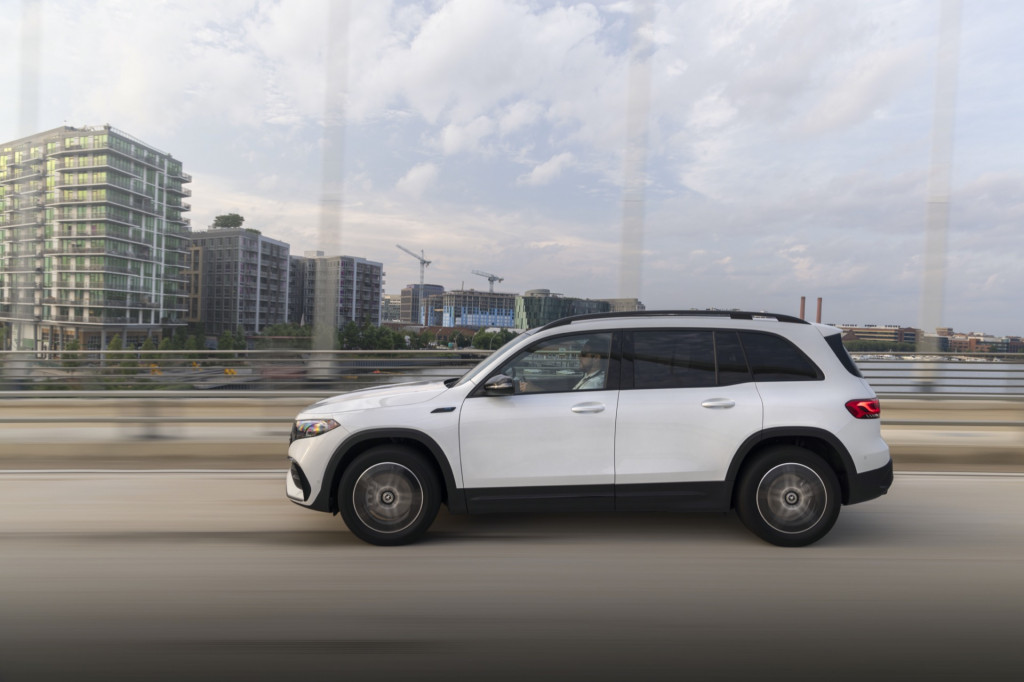
2022 Mercedes-Benz EQB 300
Mercedes plans to notify owners by mail beginning Apr. 1. Owners can also call the automaker’s customer service department at 1-800-367-6372 for more information.
Introduced for the 2022 model year, the EQB applies an electric powertrain to the GLB-Class crossover, preserving that model’s boxy profile and thus standing out in a market segment dominated by teardrop-shaped crossovers. It received a refresh for 2024 that brought a larger standard touchscreen and Plug & Charge compatibility, while keeping that distinctive shape.

Automakers want Trump DOT to restart EV charger funding
Last week’s U.S. Department of Transportation (DOT) announcement placing a freeze on the federal government’s EV charging infrastructure program has already prompted responses from a range of industry interests—including at least one that counts automakers among its membership.
In a statement first reported by Reuters, the Electric Drive Transportation Association (EDTA) asked the Trump administration to restore the National Electric Vehicle Infrastructure (NEVI) program, which the organization called “an effective and important element of a truly strategic energy policy that promotes U.S. innovation, domestic investment, and energy security.”
The EDTA counts six automakers among its members. Ford, General Motors, Mitsubishi, Nissan, Stellantis, and Toyota are part of the group along with 20 other interests including charging networks, charging-hardware suppliers, and the retail giant Walmart. Although this pushback was a statement of the group and its interests, it’s unclear which companies might have, for instance, signed onto a letter pushing for this rollback of Trump administration policy.
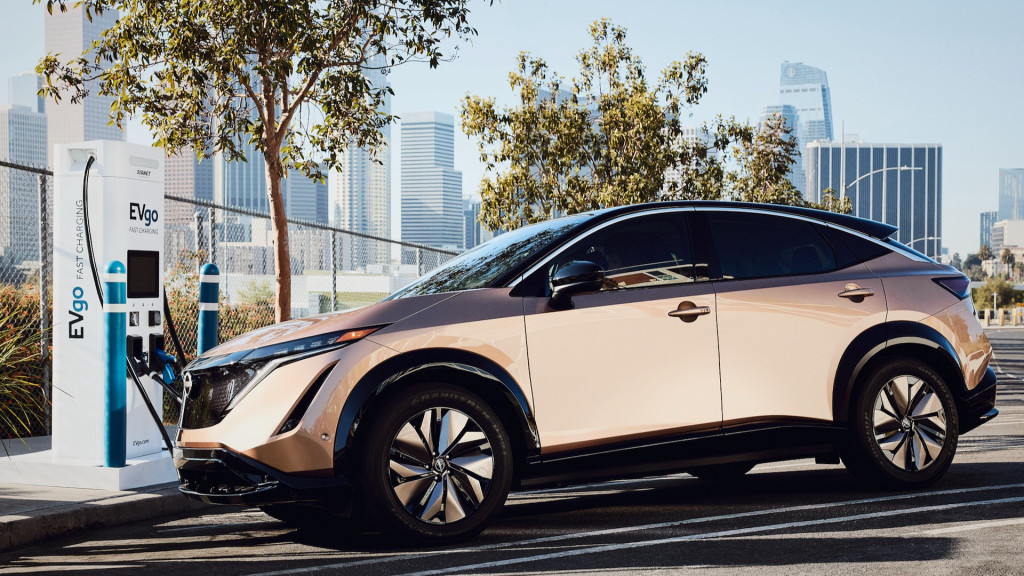
2023 Nissan Ariya at EVgo charging station
“We urge the Administration to quickly resume the critical work of the program and minimize uncertainty for states and their businesses, who have invested in infrastructure to serve local and national goals for advanced transportation,” the EDTA statement said.
The Trump DOT move announced last Thursday rescinds previous guidance for the program, which was created under the 2021 infrastructure law to disperse funding for a $7.5 billion national network, on the way to a target of 500,000 EV chargers. The agency said it would fund projects already approved but freeze funding for new projects until revised guidance is issued.
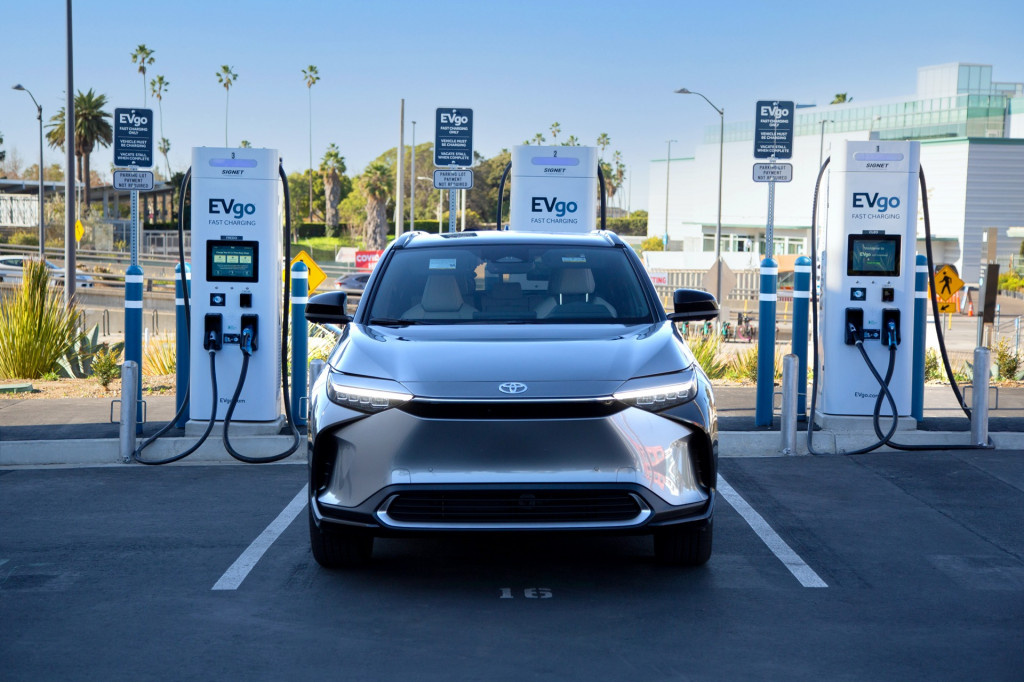
2023 Toyota bZ4X at EVgo charging station
Under the NEVI framework, states issue plans showing how they would spend available funding. The DOT has said it will make states submit new plans once altered guidance is complete, which is likely to create additional uncertainty and slow a process that was just beginning to pick up speed, even if the money isn’t actually taken away.
Several of the EDTA’s member automakers are also partners in Ionna, which has suggested that it will take advantage of the NEVI program to reach its goal of 30,000 chargers by 2030. That plan makes Ionna the most likely charging-network rival to Tesla, which has already won many NEVI contracts. That creates more financial risk to charging companies, as the funding is placed in limbo—and a growing conflict of interest as Tesla CEO Elon Musk continues to act as an unofficial advisor to the Trump Administration.

Rivian opens electric van sales to all fleets
- Rivian EDV for fleet customers starts at $82,900
- Up to 161-mile range from 100-kwh LFP battery pack
- Amazon already has more than 20,000 Rivian electric vans, of its ordered 30,000 by 2030
Rivian electric vans will soon be carrying more than just Amazon packages.
On Monday the automaker announced that it is opening sales of its commercial vans to fleet customers beyond Amazon, which originally got Rivian into the commercial vehicle business.
Rivian was exclusive with Amazon for such vehicles initially, starting in 2019, when it announced an order for 100,000 vans by 2030 as part of a $440 million investment in Rivian. But Rivian has been looking to expand sales to other customers once its exclusivity with Amazon ended. The automaker has been trialing vans “with several large fleets” to lay the groundwork for that, according to a Rivian press release.
Called the EDV (short for Electric Delivery Van), the first examples headed out into the world making Amazon deliveries in 2021. Amazon now has more than 20,000 of the vans in its fleet, according to a Rivian press release.
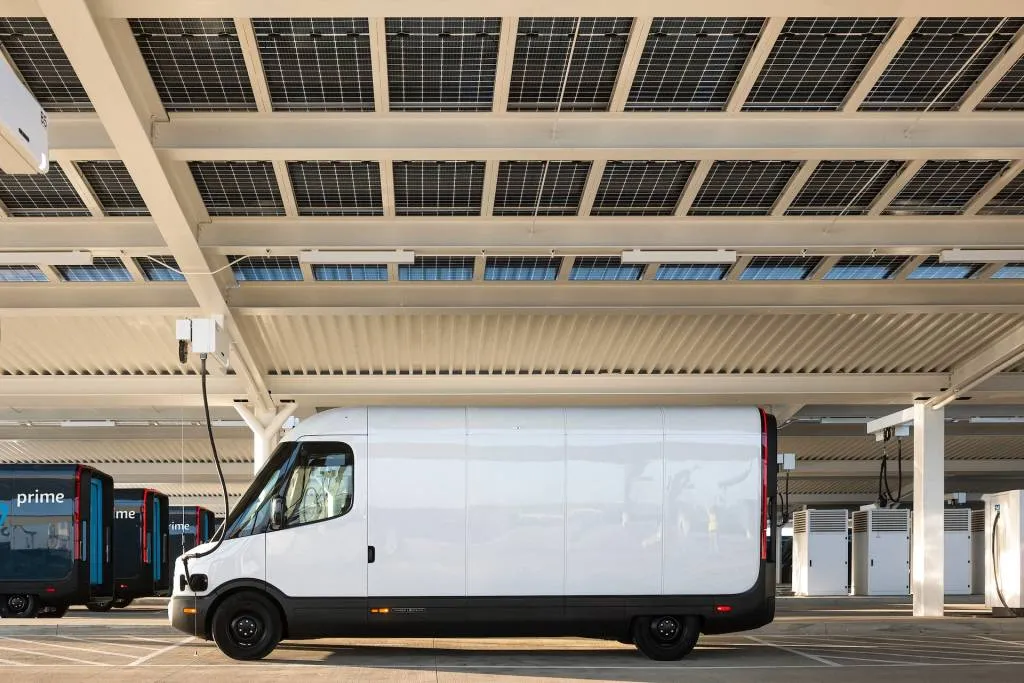
Rivian Commercial Van
Now dubbed the Rivian Commercial Van, the mass-market version shares design cues with the EDV used by Amazon. It will be offered in two configurations badged 500 and 700 priced at $82,900 and $86,900, respectively, including the $3,000 destination fee. The shorter 500 measures 248.5 inches long with a 157.5-inch wheelbase, while the 700 stretches to 278 inches long, with a 187-inch wheelbase.
The 500 has 487 cubic feet of cargo space and a 2,663-pound payload rating, while the 700 has 652 cubic feet of cargo space and a 2,258-pound payload rating. Both versions have a gross vehicle weight rating (GVWR) of 9,500 pounds.

Rivian Commercial Van
Both versions are front-wheel drive, with a single motor providing 320 hp and 299 lb-ft of torque. A lithium iron phosphate (LFP) battery pack with 100 kwh usable provides up to 161 miles of range in the 500 and 160 miles in the 700—both based on EPA drive cycles but not official EPA ratings. While Rivian has said it will adopt the Tesla NACS connector for its passenger vehicles at some point, the Commercial Van will start shipping with a CCS connector providing 100 kw of DC fast-charging power. The AC charging rate is 11 kw.
Other automakers also offer electric vans but many, such as the Ram ProMaster EV, Mercedes-Benz eSprinter, and Ford E-Transit, are electrified versions of combustion designs. General Motors’ Chevrolet BrightDrop vans, on the other hand, leverage the same component set as the automaker’s current electric passenger vehicles. Mercedes is also planning electric vans based on a dedicated architecture, called Van.EA, to be previewed by a concept vehicle later this year.

2026 Volvo EX30 Cross Country EV straps on snow boots
The Volvo EX30 electric vehicle began arriving at U.S. dealerships last month, but only in top Twin Motor Performance guise. Other versions are on the way, though, including the more rugged EX30 Cross Country, which was unveiled in Sweden Monday.
Volvo previewed the Cross Country with a concept vehicle that was unveiled alongside the production version of the standard EX30 in 2023, and the design hasn’t changed much from concept form. The Cross Country features increased ground clearance, skid plates, and 18-inch wheels that can be fitted with all-terrain tires. A load carrier, roof basket, and mud flaps are among the optional accessories offered within Cross Country Experience packages.
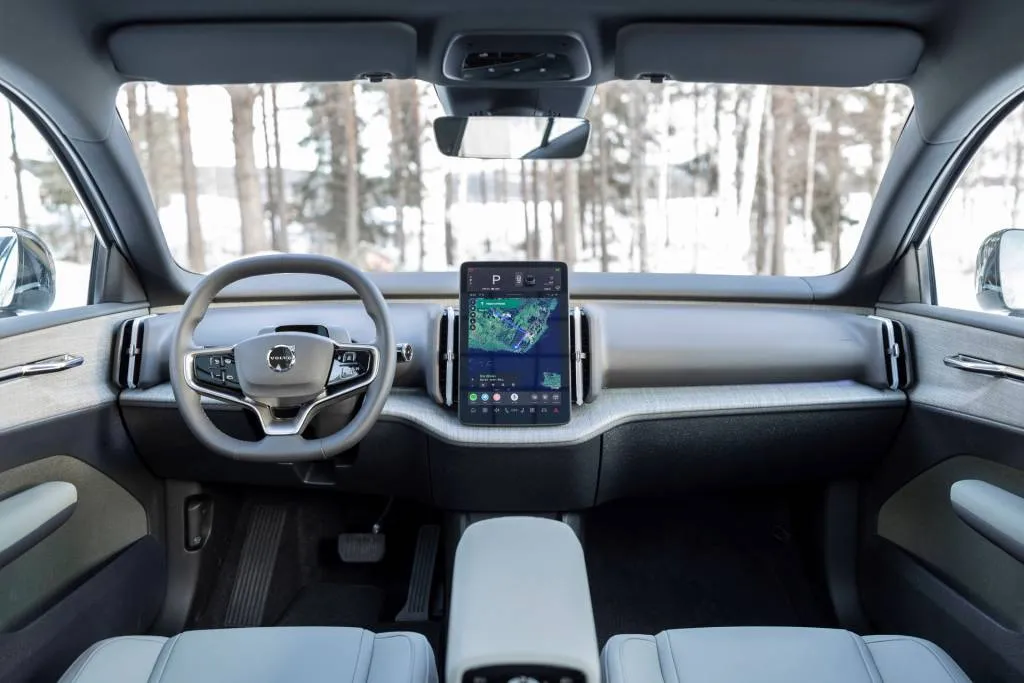
2026 Volvo EX30 Cross Country
Blacked-out panels and the front and rear also carry over from the concept, along with wheel-arch extensions. The front fascia includes a topographical representation of the Kebnekaise mountain range in northern Sweden, which Volvo says serves as an inspiration for its designers.
The EX30 Cross Country will come standard with dual-motor all-wheel drive, but Volvo hasn’t confirmed whether it will be tuned for the same 422 hp and 400 lb-ft of torque as current Twin Motor Performance models.
The Cross Country is also likely to use the same 69-kwh nickel manganese cobalt (NMC) battery pack as other U.S.-market EX30 models, with EPA range to be disclosed at a later date. Other dual-motor versions of the EX30 are currently EPA-rated at 253 miles, and Volvo projects that they can DC fast charge from 10%-80% in less than 30 minutes. That charge time is expected to apply to the Cross Country as well.
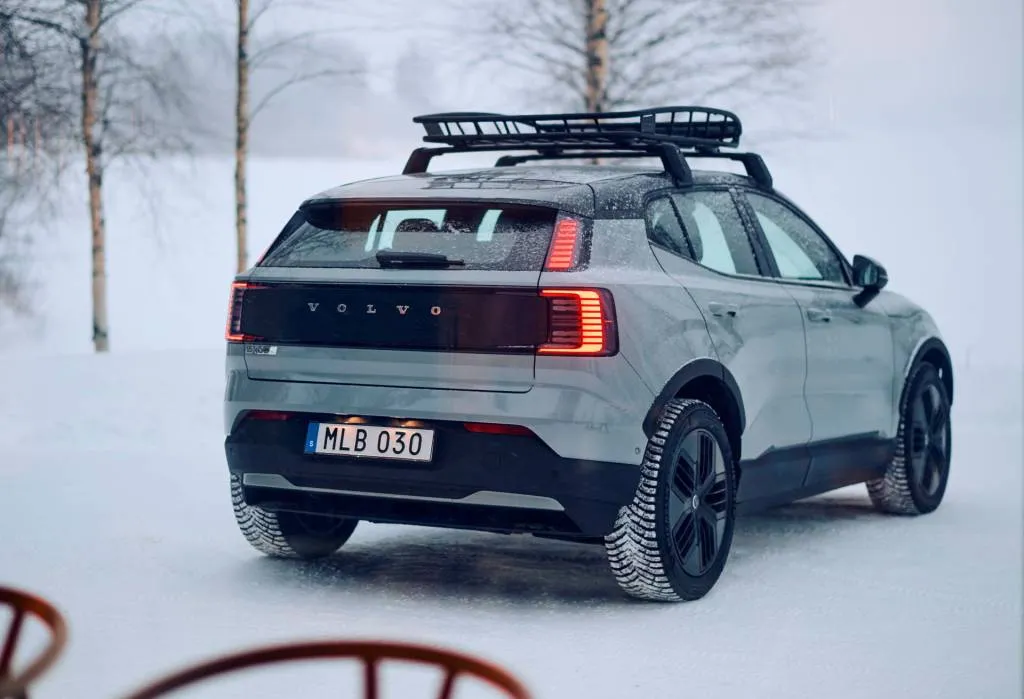
2026 Volvo EX30 Cross Country
Volvo initially planned to bring the EX30 to the U.S. last summer, but the launch was delayed after new tariffs were imposed for EVs made in China, complicating the automaker’s plans to source the first vehicles from that country before shifting production to Belgium. The China-made EX30 then reached U.S. dealerships in January only in its top dual-motor form, with a starting price of $46,195.
Volvo has promised that a single-motor version of the EX30 is still on the way, with a base price of $36,245. The single-motor EX30 and Cross Country are both expected to appear before the end of the 2025 calendar year, meaning they’ll likely be considered 2026 models.
